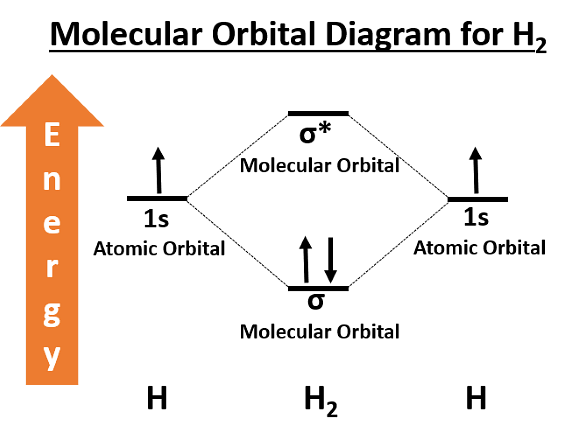The colour of the $X_2$ molecules of group $17$ elements changes gradually from yellow to violet down the group. This is due to
- the physical state of $X_2$ at room temperature changes from gas to solid down the group
- decrease in ionization energy down the group
- decrease in $p^*-s^*$ gap down the group
- decrease in HOMO-LUMO gap down the group
The Correct Option is D
Solution and Explanation
(i) decrease in $\pi^{*}-\sigma^{*}$ gap down the group
(ii) decrease in HOMO-LUMO gap down the group
Top Questions on Molecular Orbital Theory
- In the following, the number of paramagnetic molecules are: O\(_2\), N\(_2\), F\(_2\), B\(_2\), Cl\(_2\).
- JEE Main - 2025
- Chemistry
- Molecular Orbital Theory
Which of the following statement is true with respect to H\(_2\)O, NH\(_3\) and CH\(_4\)?
(A) The central atoms of all the molecules are sp\(^3\) hybridized.
(B) The H–O–H, H–N–H and H–C–H angles in the above molecules are 104.5°, 107.5° and 109.5° respectively.
(C) The increasing order of dipole moment is CH\(_4\)<NH\(_3\)<H\(_2\)O.
(D) Both H\(_2\)O and NH\(_3\) are Lewis acids and CH\(_4\) is a Lewis base.
(E) A solution of NH\(_3\) in H\(_2\)O is basic. In this solution NH\(_3\) and H\(_2\)O act as Lowry-Bronsted acid and base respectively.
- JEE Main - 2025
- Chemistry
- Molecular Orbital Theory
Which of the following linear combinations of atomic orbitals will lead to the formation of molecular orbitals in homonuclear diatomic molecules (internuclear axis in z-direction)?
(1) \( 2p_z \) and \( 2p_x \)
(2) \( 2s \) and \( 2p_x \)
(3) \( 3d_{xy} \) and \( 3d_{x^2-y^2} \)
(4) \( 2s \) and \( 2p_z \)
(5) \( 2p_z \) and \( 3d_{x^2-y^2} \)
- JEE Main - 2025
- Chemistry
- Molecular Orbital Theory
- Arrange the following in increasing order of bond order: (A) He\(_2^+\)
(B) O\(_2^-\)
(C) HF
(D) NO\(^-\)- CUET (PG) - 2025
- Chemistry
- Molecular Orbital Theory
- The sum of the bond orders of O$_2^+$, O$_2^-$, O$_2$, O$_2^{2-$, and the sum of the unpaired electrons in them respectively are
- AP EAPCET - 2025
- Chemistry
- Molecular Orbital Theory
Questions Asked in JEE Advanced exam
The center of a disk of radius $ r $ and mass $ m $ is attached to a spring of spring constant $ k $, inside a ring of radius $ R>r $ as shown in the figure. The other end of the spring is attached on the periphery of the ring. Both the ring and the disk are in the same vertical plane. The disk can only roll along the inside periphery of the ring, without slipping. The spring can only be stretched or compressed along the periphery of the ring, following Hooke’s law. In equilibrium, the disk is at the bottom of the ring. Assuming small displacement of the disc, the time period of oscillation of center of mass of the disk is written as $ T = \frac{2\pi}{\omega} $. The correct expression for $ \omega $ is ( $ g $ is the acceleration due to gravity):

- JEE Advanced - 2025
- Waves and Oscillations
- Consider the vectors $$ \vec{x} = \hat{i} + 2\hat{j} + 3\hat{k},\quad \vec{y} = 2\hat{i} + 3\hat{j} + \hat{k},\quad \vec{z} = 3\hat{i} + \hat{j} + 2\hat{k}. $$ For two distinct positive real numbers $ \alpha $ and $ \beta $, define $$ \vec{X} = \alpha \vec{x} + \beta \vec{y} - \vec{z},\quad \vec{Y} = \alpha \vec{y} + \beta \vec{z} - \vec{x},\quad \vec{Z} = \alpha \vec{z} + \beta \vec{x} - \vec{y}. $$ If the vectors $ \vec{X}, \vec{Y}, \vec{Z} $ lie in a plane, then the value of $ \alpha + \beta - 3 $ is ________.
- If $$ \alpha = \int_{\frac{1}{2}}^{2} \frac{\tan^{-1} x}{2x^2 - 3x + 2} \, dx, $$ then the value of $ \sqrt{7} \tan \left( \frac{2\alpha \sqrt{7}}{\pi} \right) $ is.
(Here, the inverse trigonometric function $ \tan^{-1} x $ assumes values in $ \left( -\frac{\pi}{2}, \frac{\pi}{2} \right) $.)- JEE Advanced - 2025
- Integral Calculus
Let $ a_0, a_1, ..., a_{23} $ be real numbers such that $$ \left(1 + \frac{2}{5}x \right)^{23} = \sum_{i=0}^{23} a_i x^i $$ for every real number $ x $. Let $ a_r $ be the largest among the numbers $ a_j $ for $ 0 \leq j \leq 23 $. Then the value of $ r $ is ________.
- JEE Advanced - 2025
- binomial expansion formula
- The total number of real solutions of the equation $$ \theta = \tan^{-1}(2 \tan \theta) - \frac{1}{2} \sin^{-1} \left( \frac{6 \tan \theta}{9 + \tan^2 \theta} \right) $$ is
(Here, the inverse trigonometric functions $ \sin^{-1} x $ and $ \tan^{-1} x $ assume values in $[-\frac{\pi}{2}, \frac{\pi}{2}]$ and $(-\frac{\pi}{2}, \frac{\pi}{2})$, respectively.)- JEE Advanced - 2025
- Inverse Trigonometric Functions
Concepts Used:
Molecular Orbital Theory
The Molecular Orbital Theory is a more sophisticated model of chemical bonding where new molecular orbitals are generated using a mathematical process called Linear Combination of Atomic Orbitals (LCAO).
Molecular Orbital theory is a chemical bonding theory that states that individual atoms combine together to form molecular orbitals. Due to this arrangement in MOT Theory, electrons associated with different nuclei can be found in different atomic orbitals. In molecular orbital theory, the electrons present in a molecule are not assigned to individual chemical bonds between the atoms. Rather, they are treated as moving under the influence of the atomic nuclei in the entire molecule.
